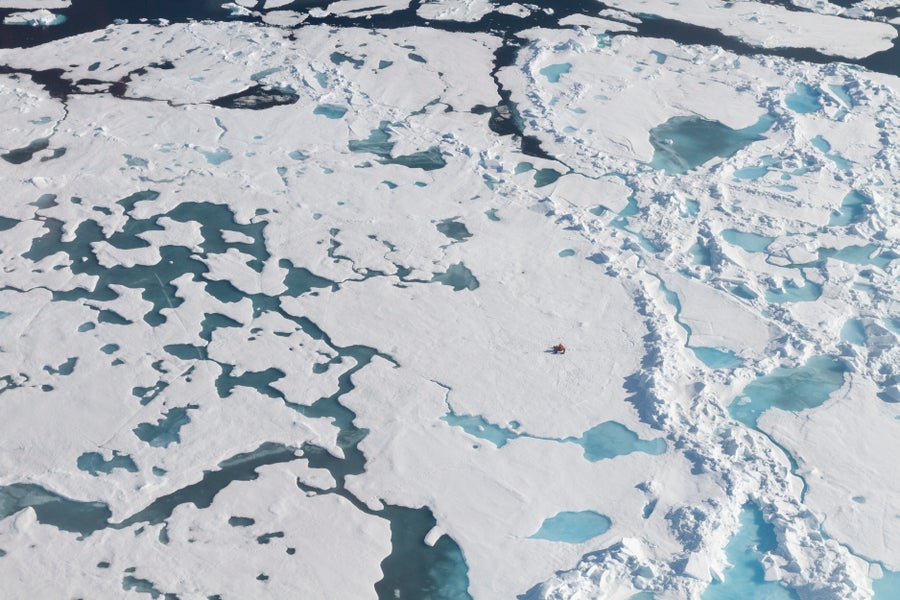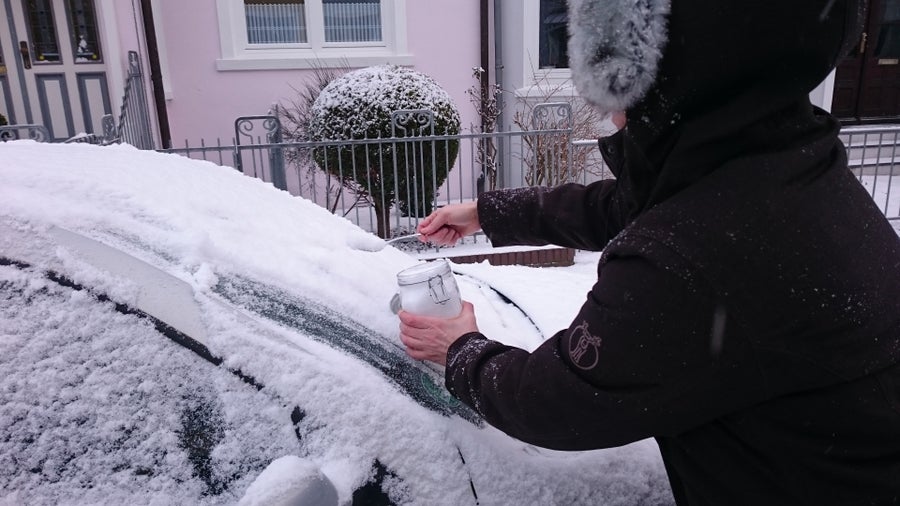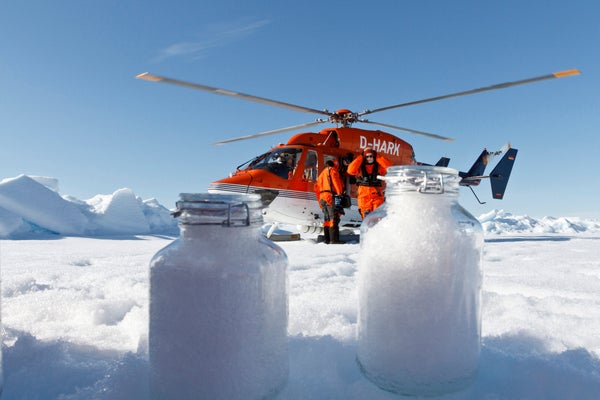A few years ago, marine ecologist Melanie Bergmann was on the remote Norwegian archipelago of Svalbard, studying the effects of climate change on Arctic marine ecosystems. She kept noticing how much plastic litter was turning up in samples and images of the nearby ocean floor. After doing several analyses, she and her team found tiny pieces of plastic permeating seafloor sediment and ocean waters and frozen into layers of sea ice. Because the Arctic has a relatively light human presence, the big question was: How was all this microplastic getting there?
We now know that at least some of it is blowing to the Arctic through the atmosphere and drifting down to the surface. That is the conclusion of a new study of Arctic snow samples conducted by Bergmann, a senior scientist at the Alfred Wegener Institute for Polar and Marine Research, and her colleagues. The work, published Wednesday in Science Advances, also provides more evidence that motes of plastic are likely constantly circulating in the atmosphere, underscoring just how ubiquitous the plastic pollution problem is. It shows “the way [microplastic is] transported around the world, even to the most remote places on earth,” Bergmann says.

Scientists appear as a speck on the ice floes as they collect samples. Credit: Mine Tekman Alfred-Wegener-Institut
On supporting science journalism
If you're enjoying this article, consider supporting our award-winning journalism by subscribing. By purchasing a subscription you are helping to ensure the future of impactful stories about the discoveries and ideas shaping our world today.
Microplastics are the tiny pieces of plastic that result from the degradation of larger plastic items, such as bags or bottles, in the environment, as well as from the synthetic fibers that can slough off of clothing and other fabric items. Their size can vary from a grain of rice down to the scale of a virus, and they come in a dizzying array of plastic polymers and added chemicals. Their small size, coupled with worries over their potentially toxic chemical load, has aroused concerns over their potential impacts on ecosystems and human health.
Because of those concerns, in recent years, a constantly expanding roster of scientists has been working to track the movement of microplastics around the planet as they are transported by rivers, carried by ocean currents and borne aloft by the wind before falling back to the ground. Their movement through the air is particularly troubling because of the risk of humans breathing them in, a possible health issue that has been little studied so far. “There’s a lot [of microplastic] out there, and this is one additional pathway that we haven’t given the attention required so far,” Bergmann says.
Studying how much microplastic was falling out of the atmosphere in the Arctic was tricky because the environment is too harsh for sophisticated air filters. “We came up with the idea to sample snow,” Bergmann says, because the snow scavenges all kinds of particles out of the atmosphere as it falls. She and her colleagues helicoptered to ice floes in the Fram Strait between Greenland and Svalbard, which lies to the north of the Norwegian mainland, to get snow samples. The team then compared what they found in the Arctic samples with snow from the moderately populated Swiss Alps and the city of Bremen in Germany.

Snow was also collected in Bremen, Germany, to compare the numbers and types of microplastic particles from an urban location that was much closer to potential sources with those from the remote Arctic. Credit: Melanie Bergmann Alfred-Wegener-Institut
As anticipated, the Arctic snow had fewer microplastic particles than samples from the other sites, which are much closer to potential sources. But the numbers in the Arctic samples were still quite high, says Deonie Allen of the Engineering Faculty of Life Sciences in Toulouse, France (ENSAT), who has studied microplastics but was not involved in this study. “We did not expect to find these high numbers,” Bergmann says. With the relatively sensitive technique she and her team used, what they found is likely the low end of what is there: study after study has found that the amount of microplastic particles rises as their size decreases, and there are particles too small for current detection methods.
Bergmann’s findings mesh with those from a recent study Allen did in the remote Pyrenees that measured atmospheric fallout of microplastics, both in terms of particle numbers and the implication that the pollution is being blown into those areas from faraway sources. Bergmann’s work “gives extra weight to the stuff that we found,” Allen says. Chelsea Rochman of the University of Toronto, who has studied microplastics in lakes, rivers, and soil and was not involved in either study, says, “Atmospheric deposition might help explain why we sometimes see microplastics in remote freshwater and terrestrial ecosystems far from an urban or industrial source.”
There is still a long way to go to figure out what the ultimate sources of this microplastic pollution are. They will likely vary, depending on location, the size and type of plastic, and weather conditions. Intriguingly, the kinds of microplastics found in the Arctic differed from those found in the Bremen and Alpine sites. Bits of polystyrene, polycarbonate and PVC, for instance, were uncovered only in the Arctic samples. Polymers found in varnish, which can be used on the exteriors of ships, were also notable in those samples. The sheer variety of possible microplastic sources means that tracing their origins “would be very difficult to get a handle on,” Bergmann says.
Untangling that messy picture will take more samples of airborne microplastic from around the globe, as well as lab experiments to see how particles of different sizes, shapes and polymer types act in various wind and weather conditions—for example, to find out if certain particles tend to stick together or which particles are most likely to be picked up and carried long distances. Both Bergmann and Allen want to see airborne microplastic collection incorporated into the routine monitoring of air quality and weather.
Bergmann’s next steps will be to measure the microplastics coming out of the various rivers that empty into the Arctic Ocean to determine if certain types are more likely to arrive via water versus air. Further work will also help to see if the Arctic acts as a collection point for microplastics in the way it seems to concentrate some other pollutants, such as mercury and pesticides, and how that process might work, Rochman says.
The presence of microplastics in the Arctic also highlights the urgent need to address rising rates of plastic production and leaky waste management systems in order to reduce the amount of plastic escaping into the environment, Allen says. Projections show mismanaged plastic waste could triple by 2060. As Allen notes, “We don’t have control of this at the moment.”
